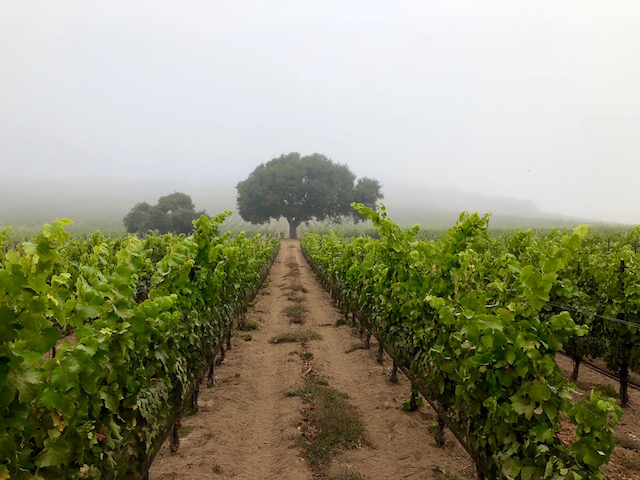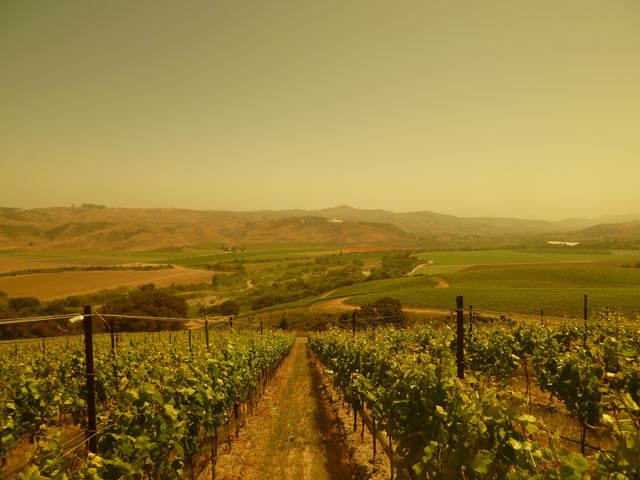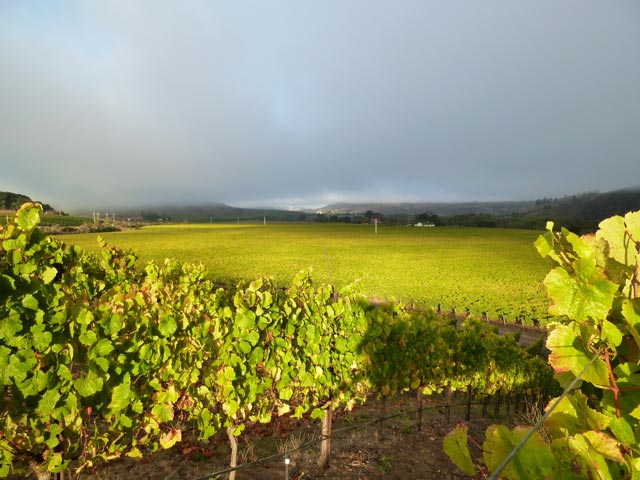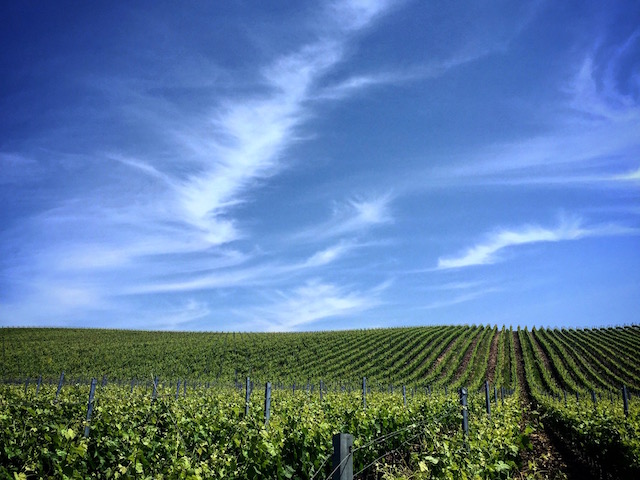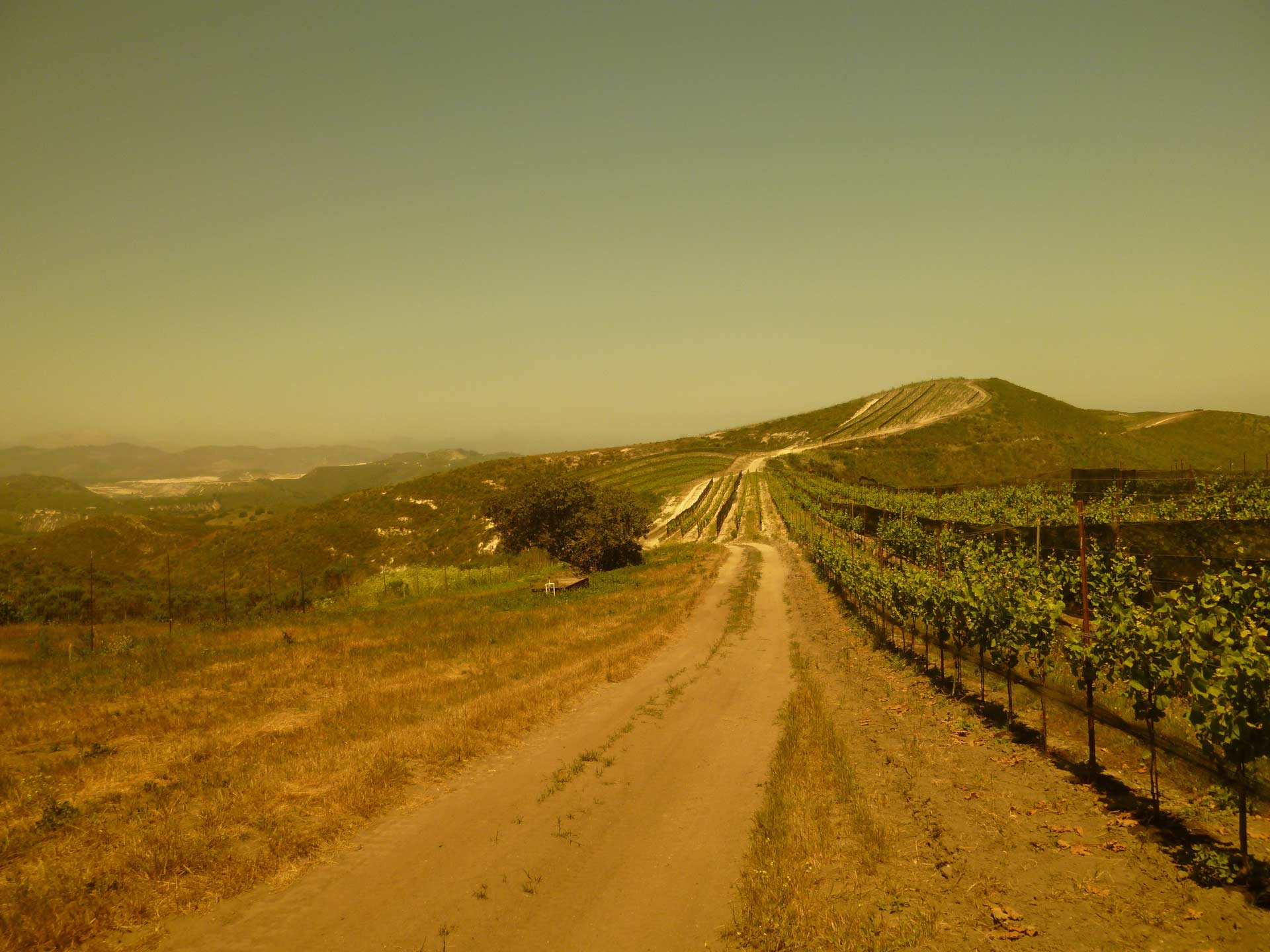Vineyards
Sauvignon Blanc
Grassini Family Vineyard
Happy Canyon of Santa Barbara AVA
Grassini is an exceptional vineyard located upon small hills and river benches of well-drained, super fine clay loam soils laced with serpentinite. Sauvignon Blanc is planted in high density (6×3) north-south rows and is meticulously managed and farmed for high quality. Wines from Grassini typically display explosive, tropical-weight, green spectrum fruits (Kiwi, Honeydew) balanced by fresh, clean and energetic acidity, with solid minerality, fascinating spice notes and only the slightest hints of fresh herbs.
Vogelzang Vineyard
Happy Canyon of Santa Barbara AVA
Vogelzang is situated on a gently sloping bed of well-drained, gravelly loam soil with patches of serpentinite. Now over 20 years old, these vines produce extraordinary Sauvignon Balance when farmed carefully for low yields and vine balance. We farm three distinct blocks at Vogelzang, each contributing concentration and complexity to the highly acclaimed single vineyard wine, as well as the Happy Canyon blend. The oldest vines are found in Block D (clone 1), which runs east west on a slight slope with clay soils with sepentinite. Block P (clone 1) runs north-south, over a gentle slope with thinner soils that limit yields. Block M-1 (musque) is west of Block P on the same hill, but the musque clone contributes a fascinating aromatic and textural profile. Wines from Vogelzang typically display intense tropical aromas and flavors (pineapple, mango, guava) balanced by brilliant, mineral laced acidity, which we find appropriate for aging in French oak barrels.
Grimm’s Bluff Vineyard
Happy Canyon of Santa Barbara AVA
Grimm’s Bluff is a Certified Biodynamic vineyard located on a south facing mesa 850 feet above sea level and 300 feet above the Santa Ynez River as it snakes out from the dam at Lake Cachuma. Soils are comprised of a 2-3 foot thick layer of sandy loam, atop a 2-3 foot layer of clay, below which is round gravel, rock and sand which used to part of the river bed thousands of years ago. The vineyard was planted in 2012 with the assistance of famed biodynamic consultant Philippe Coderey and has been lovingly farmed with minimal inputs and irrigation since. Daytimes are warm to hot, but strong ocean winds come zipping up the river valley most afternoons to cool the vineyard and lengthen the growing season. We source fruit from three blocks: the largest section is in the unique head-trained section (8’ by 3’ spacing; clone 1), while two smaller blocks are in the high density (6’ by 3’) VSP sections and include clones 1 and musque. The climate and farming here produce tiny clusters of such intense and concentrated fruit that we were “forced” to make a single vineyard wine from this unique and spectacular site.
Chardonnay
Rita’s Crown Vineyard
Sta. Rita Hills AVA
Rita’s Crown vineyard is located at one of the highest points in the Sta. Rita Hills, adjacent to such famous sites as Mt Carmel and Sea Smoke. The soils are a mix of sandy and clay loams with a good amount of diatomaceous earth. We obtain Chardonnay from two blocks here: Block 16, (clone 76) lies at 800-950 feet on a steep, west-southwest facing hillside above the monastery, and block 12 (clone 95), a steep south facing hillside just below and to the west. These higher elevation blocks are exposed to fog and clouds most mornings and high winds most afternoons, cooling the vineyard. The climate and the low vigor soils produce a small canopy, small yields and a long, slow growing season. The wines here typically show beautiful, ripe tropical fruit flavors, balanced by remarkable acidity and strong notes of chalky minerals.
Duvarita Vineyard
Santa Barbara County
Located west of the Sta. Rita Hills appellation (and thus labeled geographically as Santa Barbara County) on a south facing slope. We purchase Chardonnay from the upper slope which ranges from approximately 250 feet to 350 feet above sea level. Soils in the Chardonnay blocks include Arnold sand (deep, somewhat excessively drained soils that formed in material weathered from soft sandstone) and Marina sand (gently sloping to moderately steep rolling dune-like slopes that are essentially old sand dunes). These sandy soils are relatively poor and well drained; however, biodynamic farming, use of cover crops and composting have increased the organic material in the soil to a degree over the years, decreasing irrigation requirements and increasing sustainability.
The vineyard is lovingly farmed using biodynamic principles and is certified Biodynamic by Demeter.
Radian Vineyard
Sta. Rita Hills AVA
Radian is perched on dramatically steep slopes of clay loam with large amounts of diatomaceous earth, providing excellent drainage and giving the wines a distinct minerality. This extreme site is regularly buffeted by high winds, cooling the vineyard and robbing it of moisture. The vines here struggle to set fruit, and only a tiny crop of small clusters are able to ripen. The resulting wines are lean and intense, with a fascinating mineral streak and a remarkable depth of flavor even at low alcohol levels.
Bentrock Vineyard
Sta. Rita Hills AVA
Radian’s sister vineyard, Bentrock is perched on an undulating north-facing bench in the far western reaches of the Sta. Rita Hills AVA. Our rare block of extraordinary 76 clone Chardonnay is grown on extremely rocky shale and clay soils on a north facing outcropping that looks down upon the entire western portion of the Santa Rosa Road corridor of the Sta. Rita Hills.
Donnachadh Vineyard
Sta. Rita Hills AVA
Located along the eastern portion of Santa Rosa Road along the windswept Sant Ynez River, Donnachadh is farmed organically (though it is not certified). We source Chardonnay from a block on the steepest, highest portion of the vineyard on a north facing block of Clone 4. Here the clay loam and sandy clay loam soils contain a high concentration of rocks. This block is regularly buffeted by high winds, which cool the vineyard and rob it of moisture.
Spear Vineyard
Sta. Rita Hills AVA
Spear Vineyard is located at the eastern side of Sta. Rita Hills along the Highway 246 corridor. The vineyard has been CCOF certified organic since its inception (2014), and it is comprised of many distinct blocks in a myriad of soils, elevations and aspects. We source Chardonnay (Wente clone) from sandy soils on a very gentle, north-facing slope near the bottom of the vineyard, Pinot Noir (Swan clone) from steep north facing hillsides of sandy and clay loam to the east, and Syrah (470 and Alban 1 clones) from gently sloped north facing blocks on sandy loam soils at the western edge of the lower portion of the vineyard.
Pinot Noir
Fiddlestix Vineyard
Sta. Rita Hills AVA
Located in the far western portion of Santa Rita Hills, Fiddlestix was planted in 1998 on a bench of well drained Gazos and Botella clay loam, loaded with chert and Monterey shale. Morning and evening fogs and cool ocean breezes provide a long growing season, which produces bold Pinot Noir with signature flavors of red fruits and loads of baking spices. We have obtained fruit here since 2006, and we have produced single vineyard wines from this unique terroir since 2008. Today we obtain fruit from multiple blocks with numerous clone and rootstock combinations (clones 4, 5, 113, 115, 667, 777) in strategically selected locations.
Radian Vineyard
Sta. Rita Hills AVA
Radian is perched on dramatically steep slopes of clay loam with large amounts of diatomaceous earth, providing excellent drainage and giving the wines a distinct minerality. This extreme site is regularly buffeted by high winds, cooling the vineyard and robbing it of moisture. The vines here struggle to set fruit, and only a tiny crop of small clusters are able to ripen. The resulting wines are lean and intense, with a fascinating mineral streak and a remarkable depth of flavor even at low alcohol levels.
Bentrock Vineyard
Sta. Rita Hills AVA
Radian’s sister vineyard, Bentrock is perched on a series of undulating hills in the far western reaches of the Sta. Rita Hills AVA. Soils include Tierra Sandy Loam and Santa Lucia Shaly Clay Loam and some sections with diatomaceous earth. Fierce winds and consistent fog keep this site cool and provide for a long growing season. We farm several distinct blocks of Pinot Noir here (Clones 113, 115 and 667).
Duvarita Vineyard
Santa Barbara County
Located west of the Sta. Rita Hills appellation (and thus labeled geographically as Santa Barbara County) on a south facing slope. We purchase Pinot Noir from the upper slope which ranges from approximately 250 feet to 350 feet above sea level. the Pinot Noir is exclusively planted on Marina Sand. These sandy soils are relatively poor and well drained; however, biodynamic farming, use of cover crops and composting have increased the organic material in the soil to a degree over the years, decreasing irrigation requirements and increasing sustainability.
The vineyard is lovingly farmed using biodynamic principles and is certified Biodynamic by Demeter.
Stolpman Vineyard
Ballard Canyon AVA
A stalwart vineyard in the heart of the Ballard Canyon AVA, Stolpman is planted upon rolling hills of sandy clay loam, underpinned with limestone. We obtain Syrah from multiple blocks, some of which are from the original plantings (1996), and some from the newer (2006), high-density plantings on steep hills at the north edge of the property. Clones include 174, 470, Alban 1, and a massale selection in one block. Stolpman’s vineyard management team is second to none, and the crews have enjoyed a long tenure as part of the family (they even make and sell their own wine from the vineyard, called La Quadrilla (the “crew”)). This expert farming and low yields, results in intense, concentrated Syrah with deep, rich red fruit character, classic notes of dried meats and a distinct mineral edge.
John Sebastiano Vineyard
Sta. Rita Hills AVA
A steep, dramatic, hillside site on the border of the Santa Rita Hills appellation. We source Grenache grows on a steep, south facing hillside at the south eastern corner of the vineyard. The soil is almost pure sand on the eastern edge of the block and is slightly heavier sandy clay loam toward the west and at the bottom of the block. Grenache ripens slowly here, producing small berries of intensity and a cool, energetic, mineral-laden wine of high-toned red fruits, with great aromatics.
Our Syrah comes from three blocks. Own-rooted Clone 383 grows at the highest point in the vineyard, on a steep, south-facing slopes which are blasted with gusty winds. Clone 470 on 5BB is located on the same hill. Estrella is grown on a thin ridge of sandy soils just south of the others. These sites are among the coldest Syrah plantings in Santa Barbara, and the wines are incredibly aromatic, with classic black and red fruits, spices and balanced acidity and tannins. Our blocks at JSV are Organically farmed.
Kimsey Vineyard
Ballard Canyon AVA
Kimsey is located in the southern portion of the Ballard Canyon AVA and is located on gently undulating slopes of thin sandy soils with rocks and some limestone subsoils. Grapes here tend to yield intensely fruit-driven, spicy wines with meat and blueberry notes. Certified Organic.
Spear Vineyard
Sta. Rita Hills AVA
Spear is one of the coolest sites for Syrah in Santa Barbara. We source Syrah from multiple blocks at Spear; one block (Clone 383) is located higher up on a north facing slope at the south end of the vineyard and two blocks (470 and Alban) are found on gentle, lower elevation slopes of sand and sandy loam closer to the winery. Certified Organic.
Santa Barbara County and its AVAs
The 50 miles stretching from Point Conception to Rincon constitutes the longest east-west traverse of shoreline from Alaska to Cape Horn. Here, the Santa Ynez and San Rafael Mountains form a unique coastal range, and the inland ebb and flow of fog and ocean breezes make the region one of the coolest viticultural areas in California. Because of this geologic oddity, the ocean breezes sweep eastward, channeled by the hills and mountains that ring the region. Heading east into the foothills, the temperatures are warm during the day and very cool during the night, whereas the vineyards that lie westward toward the ocean enjoy a mild and moderate climate. Coupled with soils that run the gamut from ancient beach and diatomaceous earth to chert and limestone, there is a near-perfect place for a wide variety of wine grapes. These microclimates have been identified and are now delineated by several smaller AVAs (American Viticultural Area).
Santa Ynez Valley AVA
The Santa Ynez Valley (a larger and more general appellation) is located just north of Santa Barbara in a very unique east-west trending valley. As a result of this geography, the mountains and valleys funnel the cool winds and fog from the Pacific Ocean inland, which, along with marine-derived soils, creates an amazing array of microclimates which can grow a diversity of exceptional grapes. Our John Sebastiano Syrah and Grenache come from Santa Ynez Valley.
Sta. Rita Hills AVA
Located on the cool western margin on the Santa Ynez Valley, Santa Rita Hills (aka Sta. Rita Hills) is a true coastal AVA. Consistent wind and fog from the nearby Pacific Ocean make this AVA a chilly Davis Region I climate (the same as Champagne and parts of Burgundy). The marine soils and this special climate are ideal for growing Pinot Noir and ultra-cool-climate Syrah and Grenache. Our Sta. Rita Hills vineyard sources include Fiddlestix, Cargasacchi, La Encantada, John Sebastiano, Radian and Bentrock.
Happy Canyon of Santa Barbara AVA
Happy Canyon is located at the warmer, eastern end of the valley. The temperate climate and high-magnesium serpentine-derived soils provide an ideal location for growing Bordeaux varietals, particularly, in our opinion Sauvignon Blanc. We source our Sauvignon Blanc from key vineyards including Grassini and Vogelzang.
Ballard Canyon AVA
Located in the center of Santa Ynez Valley, the area’s newest AVA is generally a cool-climate area (UC Davis Region II); however, it enjoys significant diurnal temperature swings. Thus the area enjoys hot, sunny days moderated by cool to cold nights, brought in by post-sunset ocean breezes. The area has a fascinating mix of soils, and our vineyard sources (Stolpman, Harrison Clarke) feature thin, well drained and frankly poor soils of sandy loam, overlying pockets of limestone, which limit vegetative growth and provide minerality in the wines. Ballard Canyon is planted heavily towards the Rhône varieties, and we feel most notably, Syrah.






